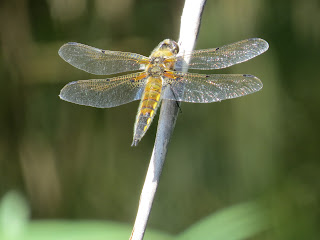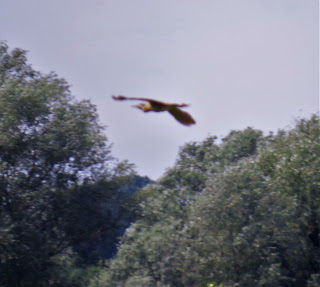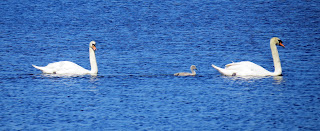 |
| Blackcap fledglings |
A stoat crossed my path as I made my way to Strumpshaw from Brundall Station this morning. A sign of great things ahead perhaps? It certainly has given me great luck on the weather. What a scorcher! Thanks to the very warm start to the morning, the insects are out early than usual. Perfect conditions for dragonflies I thought. So I decided to go look for some during my usual walk before my shift. First, I sat beside the new pond and saw some Norfolk hawkers as well as these blackcap fledglings waiting for their parents to feed them in a tree next to the pond. Then, I ventured along the meadow trail. There were plenty of four-spot chasers, hairy dragonflies and a couple of emperors. There were also plenty of horseflies, too, which plagued me and my bare legs. Insect repellent did not work at all!
 |
| Four-spot Chaser |
 |
| Banded Demoiselle |
 |
| Black-tailed Skimmer |
 |
| Garden Tiger Moth caterpillar |
Chased off the meadow trail by horseflies, I made my way along the river to where it meets the Sandy Wall path. A quick rest at a bench to restock my legs with more repellent, I noticed something crawling towards me. It was a very hairy, black caterpillar, a woolly bear! Woolly bear is just a common name for any caterpillar with a thick coat of hair, which is used as a deterrent and causes irritation to the skin when touched. This particular woolly bear will develop into a garden tiger moth.
 |
| A second one I saw after a visit to Fen Hide |
 |
| Bearded Tit |
While leaving the bench, I was quickly distracted by a cacophony of pings. A family of bearded tits flew into the reeds beside me and perched on some stems just a few metres from where I was standing. I think there was been at least 6 or more perching before me, but I was only able to get a shot of just one of them before they moved on, pinging as they went.
It was slightly busy at Strumpshaw today. The warm weather has certainly played a big part in drawing the visitors in. It wasn't long after opening up the Reception Hide until we started hearing that same question over and over. "Where's the best place to see swallowtails?" The swallowtails were certainly out today, but they were in other parts of the reserve. There was one that flew in front of the Reception Hide, though it had to make it's appearance while I was writing up today's sightings list!
 |
| Grey Heron |
The broad in front of the hide was brimming with shoals of roach and rudd that were constantly breaking the surface with synchronised leaps. Of course, this attracted attention. A hungry heron made sure it didn't miss out on this bonanza and waded through the water that was up to it's belly. It looked more like a duck than a heron at this point, but this tactic proved quite successful. It was still pretty funny watching it stare intensively at the water, while the fish were leaping behind it. I also saw two distant flights of a bittern, several marsh harriers, swallows, a buzzard, a family of mute swans, coots and a lizard.
 |
| Bittern (a pretty distant one) |
 |
| Mute Swan |
 |
| Black-headed Gul eating a fish |
 |
| Marsh Harrier |
 |
| Common Lizard |
 |
| Red-tipped Clearwing |
In the end, I wasn't able to spot a swallowtail for myself today. But that's ok, there were other things to satisfy the lepidopterist in me. The meadow brown butterflies have now emerged and I also saw brimstones, large skippers and small tortoiseshells. Amongst the plants in the nectar garden, I had a couple of orange-tip caterpillars pointed out to me. They were so well camouflaged, I was amazed how anyone was able to spot them in the first place. However, it was Ben the warden who provided me with something that was even better, a red-tipped clearwing! He was doing a survey for clearwings, using a net and a pheromone lure and caught this individual, which he brought back to show me. It looks more like a wasp than a moth doesn't it? And that is exactly the idea. Mimicry at its finest.
 |
| Orange-tip caterpillar |
 |
| Meadow Brown |
 |
| Large Skipper |





































No comments:
Post a Comment